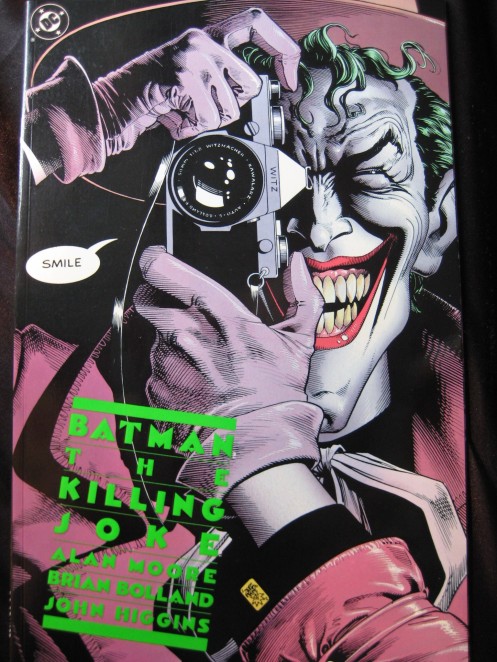
July 1988, 661,510 First Print Run, Art by Brian Bolland and Written by Alan Moore (For Mature Readers)
In this comic, the Joker tells a joke, hence the title “The Killing Joke”:
See, there were these two guys in a lunatic asylum… and one night, one night they decide they don’t like living in an asylum any more. They decide they’re going to escape! So, like, they get up onto the roof, and there, just across this narrow gap, they see the rooftops of the town, stretching away in the moon light… stretching away to freedom. Now, the first guy, he jumps right across with no problem. But his friend, his friend didn’t dare make the leap. Y’see… Y’see, he’s afraid of falling. So then, the first guy has an idea… He says “Hey! I have my flashlight with me! I’ll shine it across the gap between the buildings. You can walk along the beam and join me!” B-but the second guy just shakes his head. He suh-says… He says “Wh-what do you think I am? Crazy? You’d turn it off when I was half way across!” (taken from Wikipedia)
This comic was one that left me sitting, staring at it with my jaw dropped, thinking “Wow!” The book opens with Batman playing cards with the Joker in Arkham Asylum. There is a flashback to the Origin of the Joker.
Later in the book, the Joker escapes from Arkham. He goes to Barbara Gordon’s (AKA Batgirl’s) house and rings the doorbell (the cover image). When she answers the door, Joker shoots her and then takes pictures of her in various states of undress. The shot had gone through her spine and paralyzed her. Pretty dark, eh?
The Joker kidnaps Commissioner Gordon (Barbara’s father) and takes him to a rundown Fun House in an amusement park. He strips Gordon to his underwear and ties him up to a roller coaster car. While the ride is running, the Commissioner is forced to view pictures of his daughter nude in a puddle of blood! The Joker thought this was the best way to drive Gordon “insane”.
Batman comes and saves the day. This is the closest I ever saw Batman come to killing someone.
The end of the book is Batman playing cards with the Joker in Arkham Asylum again.
For many years, Batman comics fell stagnant, in my opinion. A lot of the 1960s and 70s Batman books were very “slapstick”, or aimed more toward kids. C’mon, who doesn’t remember the Batman TV shows with “BAM” and “POW” all over the screen. Holy time to grow up, Batman.
In 1986 Frank Miller took Batman to a new level with “The Dark Knight Returns”. Miller broke all the rules, including giving Batman a gun when everyone knows he’s anti-gun since his parents’ death. Robin was a girl, and who ever would’ve thought Superman would fight Batman? But those are different stories.
After Miller’s works on the “series” (I use the word loosely, since his contributions rarely fit in with the chronology or continuity of the regular Batman comics) a lot of “prestige format” (mature reader) comics were published. Most vigorously inhaled. I think “The Killing Joke” was the best “prestige format” comic book ever produced.








